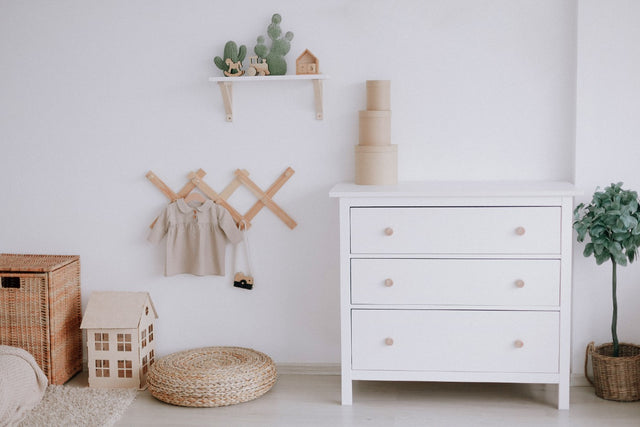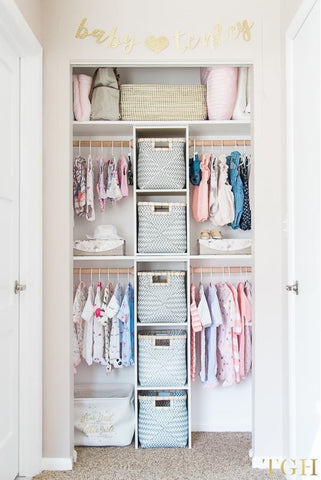How to Feng Shui Your Nursery

Note: While these nursery photos are gorgeous, please know that it’s NOT safe to place stuffed animals, pillows, bumpers, or any loose items inside your infant’s sleep space until Baby is a year old. —Dr. Harvey Karp
The ancient practice of Feng Shui, or Chinese geomancy, is a tradition that has been in use for over 3,000 years. The direct translation is “wind-water,” and the practice claims to create peace and tranquility in the home by aligning energies in a space. It involves the careful curation and arrangement of objects and lighting in a room to best promote this harmony. Sounds like a pretty good way to approach the nursery, right?
In Feng Shui, there are five elements: wood (growth), metal (intelligence), Earth (stability and balance), water (wisdom and peace), and fire (passion and inspiration). Bear these in mind while shopping, and reach for as many natural materials as possible in your decor. In addition to the construction of the items within the room, the layout matters. Ideally, you are looking to create a balance of yin (calm) and yang (energetic).
Many swear by this ancient “science” of decorating, despite a lack of solid evidence that it works. Just like many elements of parenting, it can be said that parents who “Feng Shui” their nurseries just kind of know if it’s working. Something feels right. The space is at peace. And that can be enough… especially at the end of a long day of parenting!
If you want to bring harmony and peace to your baby’s room, one thing is for sure: Designing a nursery according to principles that keep it clutter-free and harmonious in feeling should do the trick. Follow our guide on how to Feng Shui your nursery, and watch your worries melt away in a low-stress environment designed for Baby and their parents to relax, connect, and rest within.
Feng Shui Nursery Colors

Image: Nick + Alicia
In general, Feng Shui bedroom colors should be soothing and cozy. There are plenty of options, whether you’re going for a boho nursery or something more luxe. If you’re Feng Shui-ing the baby room, avoid heavily patterned wallpaper to keep the space serene and uncluttered.
Stick with one tranquil wall color and add texture and pattern in the rug as shown above. Or, utilize a pop of inspiring color with the furniture itself (a mint green crib, perhaps?). When adding color in the walls and furniture, use white or neutral trim and intentional art for a serene feeling.
The best Feng Shui paint colors for the nursery are:
- Pale blue
- Soft coral
- Rich copper
- Cream
- Warm cocoa
- Lavender
- Mint or sage green
Feng Shui Furniture & Lighting

Image: @instagram/that.boho.mama
Every element of a room’s decor and design has meaning and a proper place to allow for the best energy flow and harmonious feeling. According to the principles of Feng Shui, there is a right and wrong way to select and arrange furniture and lighting.
Furniture should be:
- Made of natural materials when possible (wood, metal)
- Rounded or curved at its edges
- The crib must not be located next to a door
This is where that fire element comes in! When talking about lighting, the brighter the better. Especially in childhood, you want a glowy space to grow, learn, and delight in life’s little pleasures. However, bear in mind that nursery lighting should follow these parameters according to the laws of Feng Shui:
- Create a bright entrance with wall sconces by the doorway to make the nursery feel inviting
- Avoid very low-hanging ceiling lights–they’re not only dangerous for curious climbers, but considered bad luck in Feng Shui
- Illuminate small, dark corners. Twinkle lights and table lamps are your friends!
- Use a dimmer to bring peace; do not hang a chandelier directly over the crib. Light is good, but tranquility is the goal.
Accessorizing the Feng Shui Nursery

Image: Be Purposed
Incorporating the principles of Feng Shui does require one to cut down on clutter and minimize the excess, but it doesn’t mean your nursery needs to be completely devoid of personality and pretty affects. Small, meaningful, and beautiful objects displayed intentionally always have a place in the Feng Shui-ed baby room.
Here’s how to decorate a Feng Shui nursery:
- Invest in sweet little hooks, simple floating shelves and bars, and thick ribbons that can be hung on the wall to display your favorite items in the baby’s room
- Edit down the selection of family photographs to one or two instead of creating an entire gallery wall
- Plants bring positivity. A hanging or potted house plant is a Feng Shui must-have; keep it safely out of Baby’s reach or go for faux
- Add paintings! Art that depicts nature or any of the elements of the practice (water, fire, Earth, metal, wood) is welcome in the Feng Shui nursery
Feng Shui Nursery Don’t’s
Energy blockers, like the use of certain colors or unharmonious arrangement of objects, in the nursery can disturb the peace. We covered most of the details above, but consider this a little cheat sheet before you put any nails in the wall or commit to a lighting fixture.
In Feng Shui, you want to avoid the following when creating a space for your baby to thrive:
- Bright, jarring colors or loud wallpaper
- Tons of art on the wall; gallery walls
- Too many books or piles of toys
- Lots of clutter
- Hard edges
And finally, resist the urge to use under-the-crib storage in the nursery, even if you’re working with a small space. Maximize your baby’s closet or store less-needed items in bins elsewhere in the home. In Feng Shui, it is believed that items should not be stored beneath the sleep space as they disturb the energy flow during sleep–and one thing every parent out there can tell you that you don’t want to mess with is sleep!

Image: The Green Spring Home